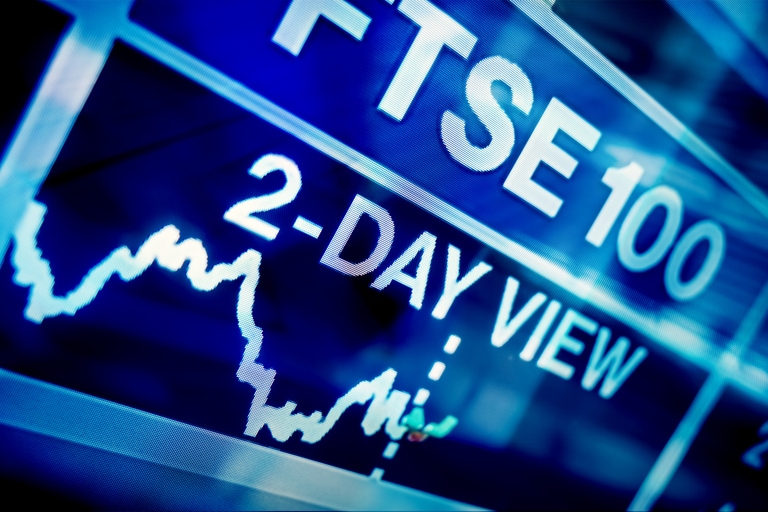European markets have undergone a modest rebound after yesterday’s negative start to the week, with the focus very much on tonight’s Federal Reserve interest rate decision, as well as tomorrow’s ECB meeting. Both central banks face an economy that is slowing, but where inflation is high, and unemployment at multiyear lows, and stress on the banking sector remains a very clear concern.
Europe
How they manage the messaging around these decisions over the next 24 hours is likely to dictate how much volatility we can expect to see between now and the end of the week.
On the plus side digital education Pearson has rebounded strongly after dropping sharply yesterday, after US peer Chegg warned ChatGPT AI chatbots could threaten its growth in homework digital help services.
The main headlines have been towards the downside with Haleon shares falling sharply despite a strong Q1 performance. Pre-tax profits came in at £542m, on revenues of £2.99bn, an increase of 9.9% on an adjusted basis. On guidance the company reiterated that it expects full year revenue growth of between 4% and 6%. Today’s weakness appears to be driven by reports that Pfizer is looking to start selling its 32% stake in the business according to CFO Dave Denton.
We’ve seen an underwhelming response to another solid set of numbers from Lloyds Banking Group today even as Q1 profits came in ahead of expectations. Statutory profit pre-tax profits came in at £2.26bn, a £ 716m increase on the same quarter last year, on net income of £4.65bn.
Net interest margin remained steady at 3.22% unchanged from Q4, and up from 2.68% in Q1 last year. The bank set aside a further £243m in respect of impairments, a modest increase from the £177m set aside in Q4, but well below the £465m set aside in Q1 last year.
It appears that, as with NatWest last week, there is disappointment that Lloyds kept full year guidance unchanged, despite the prospect of higher rates in the coming weeks and months.
While the disappointment may be understandable on one level, the caution does make sense given current events in the US, and the £8bn fall in the Lloyds deposit base over the last 12 months.
The upside to margins could be limited if UK banks have to raise rates paid to depositors to reinforce the stickiness of that base in an attempt to prevent that cash outflow, while higher rates also increase the risk of loan defaults.
Barratt Developments is giving back some of yesterday’s gains after reaffirming its guidance for full year total home completions at between 16,500 and 17,000. Net private reservations per active outlet have improved in the 12 weeks to 23rd April to 0.71, while year to date it has improved to 0.65, down from 0.93 a year ago.
UK automaker Aston Martin has continued to lose money, its Q1 operating loss rising to £50.9m even with a 9% increase in revenues to £1.27bn. Aston Martin said they expect this year to be the peak for capex spending at £370m with expectations that sales will rise to 7,000 units. Profitability is expected to improve over the second half of the year, with the deliveries of the next generation of sports cars slated for Q3.
US
After yesterday’s broad-based declines, US markets have opened slightly higher after the ADP employment report saw 269k jobs added in April, well above expectations of 148k.
More interestingly the latest ISM Services survey came in at 51.9, with prices paid edging higher to 59.6, while the employment index came in at 50.8, putting pressure on the Fed not to lean too dovish in their statement and press conference later.
The resilience in these numbers makes tonight’s Fed decision even more complicated in terms of any guidance that Powell might look to give if the central bank does indeed raise rates as expected by 25bps. Given recent volatility in regional US banks the Fed may have to make choice between still looking to keep a lid on inflation, or risk further bank weakness and possible recession. Who’d be a central banker?
Yesterday’s rout in the likes of US regional banks including PacWest and Western Alliance, has prompted concerns that the crisis could be set to spread further, with further choppiness in prices seen today, as we head towards today’s Fed decision.
Advanced Micro Devices shares have fallen sharply after the chip maker warned that Q2 revenue was likely to fall short of expectations of $5.51bn, at around $5.3bn, on gross margins of 50%. For Q1 the company was able to beat forecasts, coming in at $5.31bn in revenue and profits of $0.60c a share.
FX
The US dollar has come under pressure ahead of today’s Fed meeting with broad based declines across the board, on speculation that we might see either a dovish hike, or a hold from the central bank due to the turmoil currently rippling through the US banking sector.
The euro is back above the 1.1000 area ahead of tomorrow’s ECB rate decision, while the pound has recovered above the 1.2500 area, as it looks to retest the April highs.
The Japanese yen has been the main gainer so far; however, the current picture could change quite rapidly if the Fed delivers a hawkish surprise.
Commodities
Crude oil prices have continued to slide as the rising prospect of a US economic slowdown raises concerns over future demand. The banking crisis is likely to trigger a tightening of credit conditions which could also constrain economic activity, sending US WTI prices below $70 a barrel, and towards their March lows below $65 a barrel.
Brent crude is also below $75 a barrel although the downside could well be limited if OPEC+ decide on further production cuts to mitigate the effects of lower demand.
Yesterday’s slide in bond yields saw gold prices jump back above $2,000 an ounce, with a dovish decision later today potentially offering the opportunity of a retest of the highs last month. Today’s US dollar weakness is also helping to buoy prices.
Volatility.
With earnings news back in focus, single stock volatility for some of the heavyweights has been back in play. HSBC was one such example here where higher interest rates served to boost revenues and pave the way for a $2 billion share buyback.
One day vol on the Hong Kong listing of the stock advanced to 93.41% against 39.59% for the month. BP also fared well in terms of earnings although bumper profits were accompanied by news that the pace of its share buyback would be reined in, taking a toll on the stock as a result.
The underlying fell by more than 5%, pushing one day volatility to 69.81% against 35.02% for the month. A surprise rate hike from the Reserve Bank of Australia served to deliver elevated levels of price action on the Aussie Dollar against multiple currencies. AUD/JPY was the standout here, although the gains of around 1.3% proved to be short lived with the cross ultimately ending the day lower. One day vol stood at 19.09% compared with 11.06% on the month.
Sugar prices remain the most active in the commodities sector, with the underlying breaking back below the 26 cents per pound level for the first time in a week. There’s still a degree of uncertainty as to how harvests globally will fare in the months ahead, but off the back of that recent upside where prices rose 50% over the last six months, the temptation to book profits appears to be evident. One day volatility for raw sugar printed 59.12% against 46.75% for the month.
CMC Markets erbjuder sin tjänst som ”execution only”. Detta material (antingen uttryckt eller inte) är endast för allmän information och tar inte hänsyn till dina personliga omständigheter eller mål. Ingenting i detta material är (eller bör anses vara) finansiella, investeringar eller andra råd som beroende bör läggas på. Inget yttrande i materialet utgör en rekommendation från CMC Markets eller författaren om en viss investering, säkerhet, transaktion eller investeringsstrategi. Detta innehåll har inte skapats i enlighet med de regler som finns för oberoende investeringsrådgivning. Även om vi inte uttryckligen hindras från att handla innan vi har tillhandhållit detta innehåll försöker vi inte dra nytta av det innan det sprids.






